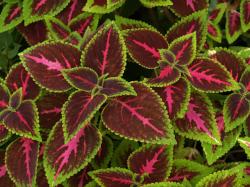Two Other Downy Mildews To Know, Coleus & Basil Downy Mildew
April 3, 2013 | 1 min to read

Impatiens downy mildew isn’t the only downy mildew you need to worry about! There are other downy mildews to be concerned about and to watch for in your greenhouse. Quick reviews of two other downy mildews to know, coleus downy mildew and basil downy mildew, are presented below.
Coleus Downy Mildew Coleus downy mildew is caused by a species of Peronospora and was first reported in the United States in 2005. This downy mildew disease causes irregular- shaped discolored or necrotic areas on coleus foliage, which are often (but not always) angular in appearance. Leaves can also curl, twist, and drop. The gray-brown fuzz of the pathogen’s sporulation will be found on the undersides of leaves showing symptoms. Careful inspection, a welllighted area, and a handlens might be necessary to see the sporulation. The sporulation tends to be easiest to see on the non-variegated dark-leafed cultivars and more difficult to see on others.
Both seed and vegetative cultivars of coleus are susceptible as well as agastache. The good news is that there is variation in the susceptibility of coleus cultivars – some are very susceptible and can defoliate while others are less affected. Michigan State and Cornell Universities have conducted experiments testing coleus cultivars for downy mildew susceptibility and numerous cultivars were found that are less susceptible. Cultivars with low susceptibility include:
To read the rest of the story, please go to: Cornell Cooperative Extension of Suffolk County
